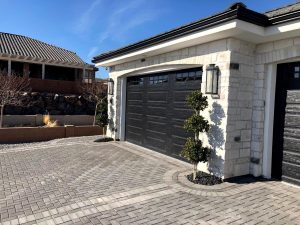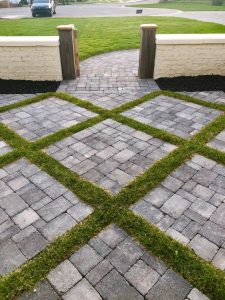
Picture a driveway that channels summer cloudburst water straight back into the ground instead of the gutter, all while looking as polished as natural stone. Permeable pavers make that possible, and our team at Strong Rock Pavers is excited to help you harness this technology for a more resilient, eco-friendly home exterior.
What Makes Permeable Pavers Different?
Conventional interlocking pavers sit tight against one another, shedding rain the same way a concrete slab would. Permeable systems widen the joints and fill them with angular, clean-washed gravel. Tiny openings guide water through the surface, into an open-graded aggregate base, and finally down to the soil. The paver itself isn’t porous; the system is.
A typical cross-section includes:
- Concrete or clay paver units with spacer tabs that create uniform gaps.
- Joint infill of #8 or #9 clean stone to keep openings clear.
- Open-graded base layers (usually #57 and #2 stone) that store several inches of water during a fast storm.
- Geotextile fabric to separate native soil from the base and maintain permeability.
- Optional underdrain when clay soils limit infiltration.
Because each component is modular, repairs are as simple as lifting units, adjusting the base, and putting them back—no heavy demolition required.
Four Big Wins for Utah Driveways and Walkways

1. Storm-Runoff Reduction
Along the Wasatch Front, summer monsoons can drop more rain in an hour than dry soils can swallow. Permeable pavers act like a sponge for that first flush, slowing flow, filtering pollutants, and easing pressure on storm drains. Many Utah municipalities now credit permeable pavement toward Low-Impact Development (LID) requirements for new construction.
2. Groundwater Recharge
Utah ranks among the driest states in the nation, and every gallon that soaks into your yard instead of flowing to the curb supports local aquifers and thirsty landscaping. Over time, groundwater recharge can even help stabilize street trees stressed by hot, compacted park strips.
3. Freeze-Thaw Resilience
Each winter brings repeated cycles of day-time thaw and night-time refreeze. Because water drains through permeable joints instead of pooling on the surface, there is less opportunity for ice to expand and crack. Concrete pavers are already tested for freeze-thaw durability; paired with a free-draining base, they outperform poured slabs that trap moisture.
4. Safer Walking and Driving
Reduced standing water means fewer icy patches and puddles around entryways. A permeable surface also melts snow faster because heat from the ground radiates upward, warming the pavers while meltwater immediately drains away.
Design Essentials for Driveways
- Sub-base depth – For passenger-vehicle traffic we excavate 12–18 inches and install multiple layers of open stone, compacting each lift for strength.
- Foundation setbacks – Utah guidelines recommend keeping permeable pavement at least 10 feet away from basement walls unless an impermeable liner is used. This protects foundations from chronic moisture.
- Edge restraints – Concrete curbs or buried plastic edging hold pavers tight under braking loads.
- Slope and overflow – Even though water goes through, surfaces still need a gentle crown or side slope toward an emergency overflow in case of extreme events.
- Surface pattern – Herringbone configurations provide maximum interlock under turning cars; soldier-course borders give crisp visual framing.
Design Essentials for Walkways & Garden Paths
- ADA-friendly joints – We limit opening widths to stay compliant while still delivering infiltration.
- Lighting integration – Flush, low-voltage LEDs fit neatly between units and stay clear of lawn-mower blades.
- Border in-lays – A contrasting color or soldier course defines path edges and makes night navigation easier.
- Minimal excavation – Foot traffic areas often need only 8–10 inches of base, saving cost and preserving tree roots.
Navigating Utah Stormwater Rules
The Utah Department of Environmental Quality actively promotes permeable pavement as a best management practice for new developments that must meet MS4 stormwater permits. When you install a permeable driveway or walkway, you help your city reduce pollutant loads and meet statewide water-quality goals—often without extra paperwork because the system is classified as landscaping rather than hardscape.
How We Build a Permeable Surface That Lasts
- Complimentary consultation
We visit your site, discuss drainage challenges, and measure slopes. - Detailed 3-D rendering
Our design shows colors, borders, and predicted water flow so you can visualize the finished space. - Precise excavation & base prep
Soils are removed to design depth, edges are defined, and subgrade is proof-rolled for strength. - Layered stone placement
Open-graded aggregate is placed in six-inch lifts and compacted. If required, we install an underdrain at the bottom layer. - Paver laying & joint filling
Units are set by hand or machine, joints filled with clean chip stone, and the surface vibrated to lock everything tight. - Walk-through & warranty
You inspect the final product, ask questions, and receive care guidelines. Our workmanship includes a lifetime material warranty, so you can relax knowing your investment is protected.
Maintenance 101
- Quarterly vacuum sweep – A shop vac or specialized surface cleaner removes sediment that could clog joints.
- Annual joint-stone top-up – We’ll add more #9 chip if natural settlement creates minor voids.
- Avoid fine sand and rock-salt – Use calcium-based de-icers in winter and broom snow rather than scrape.
- Check edge restraints every few years for heave or spread; quick fixes prevent bigger issues.
With these simple habits, a permeable driveway or walkway can serve you for decades with minimal upkeep.
Sustainability Snapshot
When we compare the life cycle of a permeable paver system to asphalt or poured concrete, three points stand out:
- Longer service life – Concrete pavers often exceed 50 years with routine care, whereas asphalt typically needs resurfacing every 12–15 years.
- Low embodied energy – Though initial material production carries a carbon cost, the capacity for repair rather than replacement keeps long-term emissions lower.
- Urban heat reduction – Many paver colors have high solar reflectance, keeping surrounding air temperatures cooler during hot Utah summers.
Ready to Go Permeable?
Upgrading to a permeable driveway or walkway is more than a curb-appeal refresh—it’s a way to support sustainable water management, protect local infrastructure, and enjoy a safer, more durable surface year-round. If you want to explore design ideas and see how permeable pavers would work on your property, let’s talk.
Call our team at (435) 703-8937 or send us a quick note through our contact page. We’ll arrange a complimentary site visit, share material samples, and prepare a custom 3-D concept that meets your goals.
Bringing It All Together
Permeable pavers give you the best of both worlds: an attractive, customized hardscape and a practical solution for stormwater challenges. Add in freeze-thaw durability and low maintenance, and you have a surface ready for Utah’s unique climate. Let’s transform your driveway or walkway into a sustainable showcase—one that serves your family today and safeguards Utah’s water tomorrow.

